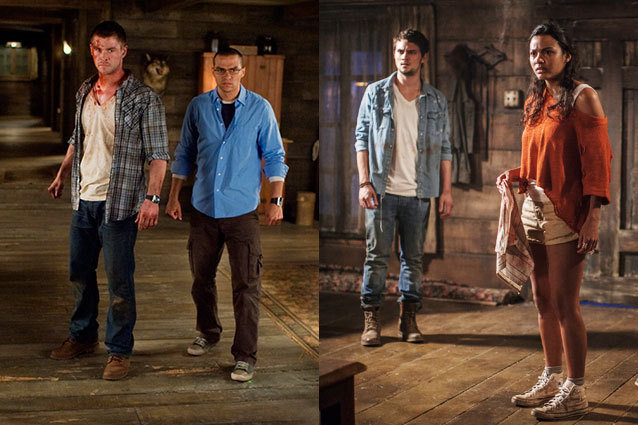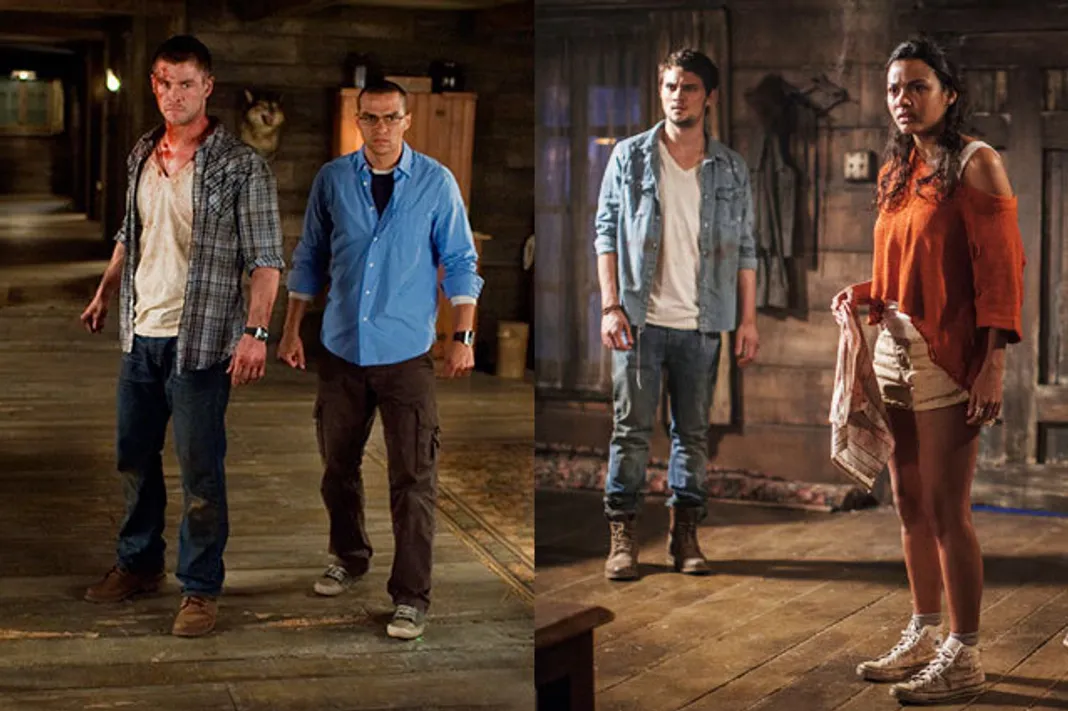
Crafting a horror remake is always a bit of a double-edged sword. On the one hand, there is an implied obligation to the fanbase of the original movie. These fans, most ardent when it comes to this particular genre, expect the spirit and, to a certain extent the content of the progenitor movie to be alive and well within the narrative of the remake. However, were the new film to be a shot-for-shot remake of the original, it would equally earn the rancorous bile of horror fans. The task is daunting and unenviable.
Evil Dead remake director Fede Alvarez, on the other hand, is dealing with a triple-edged sword…a glaive even. He has to remake a classic, showing reverence to its fans and finding new story avenues, all the while dealing with the fact that the film from which he is drawing inspiration is so iconic that it’s become a genre in-joke. More specifically, the standardization of its central conceit made it the ideal basis for the most self-aware horror film possibly ever made: The Cabin in the Woods.
With Cabin in the Woods, Joss Whedon and Drew Goddard constructed an Aristotelian deconstruction of horror that reduced decades’ worth of titles to its most basic, primal forms. The core of nearly every scary movie is the idea of isolation; of being severed from society and thereby more vulnerable to any number of interchangeable supernatural threats. Simultaneously we so often deal with youthful rejection of adult supervision. The cabin in the woods itself is a mythic representation of that isolation, that freedom from supervision. It was Sam Raimi’s Evil Dead that permanently forged this representation; canonizing campfire iconography into genre lore.
What this means for the Evil Dead remake is that it’s not just a return to the world of Raimi’s universe, but indeed a double-dip into redefinition. For crying out loud, the titular cabin in the woods in Goddard’s film is a near exact recreation of the cabin from The Evil Dead. Stepping over that threshold again therefore carries an added sense of déjà vu. The curtains have been pulled back, and audiences are now hyperaware of convention. Clever reinvention, of many benchmark horror films but Raimi’s Evil Dead in particular, has already been achieved, and places the Evil Dead remake well in danger of appearing redundant; or worse, as a step backwards. How can the wheel again be…reincarnated?
Elements of the Raimi world, of the central setting, no longer belong solely to Evil Dead. In fact, Cabin in the Woods’ retroactive re-contextualizing can actually create an entirely new perception for contemporary viewers of Alvarez’s film. In tweaking the story construct from Raimi’s Evil Dead, just enough to establish its own identity and avoid the aforementioned shot-for-shot retread, Alvarez has made it possible for us to think of his Evil Dead as the last successful scenario executed by Hadley and Sitterson. Both the new Evil Dead and Cabin in the Woods, each nodding to the Raimi original, chart a bursting open cellar door and the reading of ancient words from a sinister book as their inciting actions. The young inhabitants of the cabin are then dispatched by a malevolent supernatural presence. The ancient ones are appeased; world keeps on spinning.
Is it fair to judge the Evil Dead remake against a satire that utilizes Raimi’s Evil Dead as part of a diverse arsenal of dissected mainstays? No, but that is precisely the connection that will be drawn in the minds of those who have seen both movies. So how does Alvarez’s film combat this inevitable comparison? Is the studio even aware or concerned about it?
When one views the new Evil Dead, apart from the correlation to Cabin in the Woods, the other major item of note is the film’s excessive violence. If the original Evil Dead was gory, and Cabin in the Woods a bloodbath, then the new incarnation of Evil Dead is a hellish parade of torment soaked in tanker trucks full of blood. Point of fact, it’s one of the goriest studio films in recent memory. Granted, the vast majority of these grisly effects are achieved practically so there is artistry at play that prevents the remake from being labeled as total exploitation. However it may be argued that the violence will create enough of a spectacle as to alleviate the remake feeling like white noise for the viewer in the wake of Cabin. Whether this is the studio’s intent, it will benefit them to no end.
There are also some gender role reversals at play in Alvarez’s Evil Dead that may aid in its distinction from Cabin in the Woods, but then Goddard’s film is also marked by significant turnabouts, so the carnival-like atmosphere the violence creates is still of vital importance.
From Our Partners: 40 Most Revealing See-Through Red Carpet Looks (Vh1)
40 Most Revealing See-Through Red Carpet Looks (Vh1) 33 Child Stars: Where Are They Now? (Celebuzz)
33 Child Stars: Where Are They Now? (Celebuzz)


